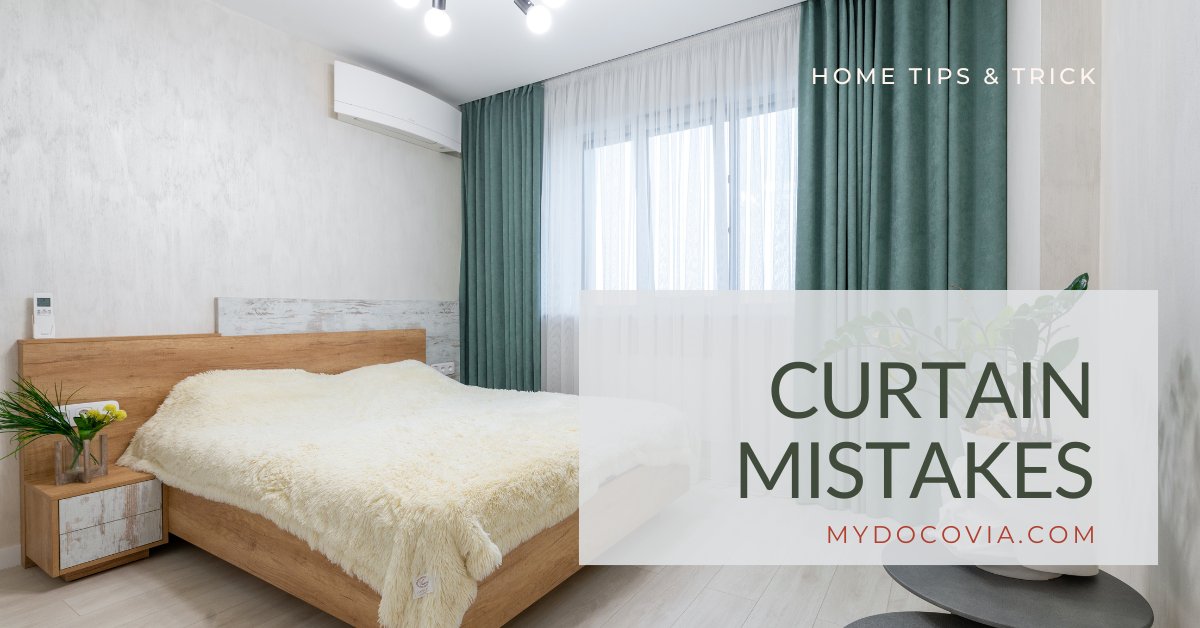Curtains are more than just window coverings—they frame your space, influence how light moves through a room, and significantly impact the overall mood of your home. Yet, many people underestimate just how easy it is to get them wrong. A few small missteps can turn a stylish room into one that feels cramped, cheap, or unfinished.
From rods hung too low to choosing fabric that fights rather than flatters your décor, curtain mistakes are all too common—and completely avoidable. Whether you’re redecorating, moving into a new space, or just want to refresh your interiors, knowing what not to do is just as important as knowing what works.
In this guide, we’ll reveal the nine most common curtain mistakes that can sabotage your style—and more importantly, how to fix them. With these expert tips, you’ll elevate your window treatments and bring polish and purpose to every room.
1. Don’t Hang the Curtain Rod Too Low or Too Narrow
One of the most common—and most damaging—mistakes is placing the curtain rod too close to the window frame. When the rod sits low, it visually shortens the wall, making the room feel squat and less elegant. The fix is simple but powerful: raise the curtain rod. Hanging your curtains 4 to 10 inches above the window frame (or even just below the ceiling line) instantly creates the illusion of height, adding a sense of grandeur and openness to the space.
Equally important is the width. A curtain rod should extend beyond the width of your window—typically by at least 10 to 15 cm (4 to 6 inches) on each side. This allows the curtains to frame the window without blocking natural light when open. It also makes the window look larger than it actually is.
By adjusting both height and width strategically, you not only improve the proportions of the room but also maximize light, enhance symmetry, and create a more refined visual flow.
2. Avoid Curtains That Are Too Short or Too Long
Curtains that hover awkwardly above the floor can make even the most carefully styled room look amateurish. The ideal curtain length depends on your aesthetic preference, but it should always be intentional. There are three popular styles:
- Floating: Curtains hang about 1 cm above the floor—clean and modern.
- Kissing: Curtains just touch the floor—adds elegance without dragging.
- Puddling: Curtains pool on the floor—luxurious and dramatic (but high-maintenance).
To avoid mishaps, measure carefully from the mounting point of your rod (after determining height placement) to your preferred length endpoint. Always measure in multiple spots as floors can be uneven.
Too-long curtains can look messy, while too-short ones can feel like pants that don’t reach the ankles. Opting for the right length ensures your curtains look deliberate and enhances the room’s overall design coherence.
3. Skip Skimpy or Too Fat Curtain Panels
Many homeowners underestimate how wide their curtains should be. A single narrow panel stretched tight across a window doesn’t just look skimpy—it also ruins the curtain’s natural drape and flow. Ideally, the combined width of all curtain panels should be 2 to 2.5 times the width of the window (even more for thicker pleats or dramatic folds).
For example, if your window is 100 cm wide, your curtains should span 200 to 250 cm when fully closed. This ensures they look full and rich even when drawn.
Likewise, overly bulky panels on narrow windows can overwhelm the space and make it feel crowded. Balance is key—measure your window width, factor in your desired fullness, and choose panel widths accordingly. Consider using multiple panels for large windows or a continuous track system for a sleek, seamless look.
4. Don’t Choose Cheap or Inappropriate Fabrics
The fabric you choose can completely transform the look and function of your curtains. Lightweight polyester might be easy on the wallet, but it often lacks the drape, texture, and durability needed for a polished, high-end finish. Worse, some fabrics hang stiffly, resist pleating, or even fade quickly under sunlight.
Instead, invest in quality materials suited to your needs:
- Blackout fabrics for bedrooms and media rooms
- Sheers or linens for airy, light-filled spaces
- Medium-weight cotton or velvet for elegance and insulation
The right fabric will fall naturally, hold its shape over time, and match the functional requirements of your room. Think beyond aesthetics: if your curtains need to block light, retain warmth, or resist humidity, fabric choice is not just about looks—it’s about longevity and comfort.
Choosing a high-quality, room-appropriate material instantly enhances both form and function, giving your space a more intentional and luxurious feel.
5. Avoid Color or Pattern Clash
A curtain’s color or pattern can either harmonize beautifully with your decor or stick out like a sore thumb. Choosing the wrong one can create a visual dissonance that throws off the balance of the entire room. For example, bold patterns may compete with busy wallpaper, while bright colors might clash with neutral palettes.
Here are a few simple rules to guide your selection:
- Match tones: If your room features cool tones, choose similarly cool-colored curtains (blues, grays, greens). The same goes for warm tones.
- Balance patterns: Pair patterned curtains with solid walls or vice versa. If both are patterned, ensure one is subtle.
- Use complementary or analogous colors: These create harmony without being overly matchy-matchy.
Curtains occupy a large vertical space in any room. If they clash with walls, furniture, or rugs, the result feels chaotic. A carefully chosen color or pattern not only ties the room together but also creates a mood—calm, cozy, dramatic, or playful.
6. Don’t Overlook Quality Hardware
Even the most beautiful curtains can be let down by flimsy or mismatched hardware. Cheap rods may sag, brackets might not hold weight properly, and poor-quality finials can break or tarnish quickly. On the other hand, oversized or gaudy hardware can distract from the curtains themselves.
Choose rods that are sturdy enough to support your curtain’s weight—especially if you’re using heavier fabrics like velvet or layering drapes. For wider windows, consider a center bracket for support. Finials should match the style of your decor: sleek metal for modern spaces, carved wood for traditional interiors, etc.
Equally important is ensuring the hardware is proportionate to your curtains and window size. A rod that’s too thin can look out of place, while one that’s too thick may dominate the window.
Investing in well-crafted, appropriately scaled hardware doesn’t just make your curtains function better—it elevates the entire room’s design.
7. Avoid Ignoring Ironing/Steaming and Training Drapes
Even the most luxurious curtains can look sloppy if they’re wrinkled or fall in uneven folds. Many people hang curtains straight from the package, overlooking a critical final step: steaming or ironing. Wrinkles distract the eye and diminish the visual appeal of your window treatments.
Start by using a handheld steamer or a garment steamer to smooth out creases after hanging. Alternatively, you can iron them before installation—but be sure to check fabric care labels to avoid damage.
Beyond wrinkle removal, training your drapes is a pro-level trick for a polished look. This involves shaping the folds manually and tying them loosely (with soft bands) in their pleated form for a few days. The fabric “remembers” the folds, resulting in consistent and even draping.
These finishing touches take a bit of extra effort but dramatically increase the curtains’ aesthetic value, making them look tailored and intentional rather than rushed and random.
8. Don’t Sacrifice Function for Form
While aesthetics are important, curtains also serve critical functions: light control, privacy, insulation, and sometimes even noise reduction. Choosing curtains based solely on looks can lead to frustration when the practical needs of the room aren’t met.
For instance:
- Living rooms may benefit from layered sheers and blackout drapes to balance light and privacy.
- Bedrooms typically need total light-blocking or thermal curtains for comfort and rest.
- Bathrooms or kitchens require moisture-resistant and easy-to-clean options.
Function can also drive installation choices: tie-backs, double rods, motorized systems, or top-down mechanisms can enhance usability without sacrificing style. The key is to plan ahead—understand the room’s requirements and choose curtains that meet both your functional and design goals.
When form and function work together, your curtains won’t just look good—they’ll make your life easier.
9. Avoid DIY Missteps if You’re Not Equipped
It’s tempting to go the DIY route when hanging curtains—especially when trying to save money. But misjudging measurements, choosing improper hardware, or uneven installations can leave your windows looking wonky and unprofessional. What should be a simple upgrade can quickly become a frustrating, uneven, or even damaging experience.
Unless you’re confident in your tools and skills, don’t hesitate to bring in help. Many home stores offer measuring and installation services, and custom curtain makers often include this in their packages. If you do decide to go DIY, invest in a quality level, measuring tape, anchors for wall type, and watch tutorial videos.
Also, consider the value of custom-made curtains. While more expensive, they’re tailored to fit your windows exactly—no compromise on length, width, or fabric quality. If custom isn’t in the budget, be sure to shop with exact dimensions and bring samples to match colors and textures.
Professional touches go a long way in achieving a seamless and high-end look, making the investment worth it in the long run.
Conclusion
Curtains may seem like a minor detail in home design, but the truth is—they hold the power to make or break a space. The most common curtain mistakes often come down to rushed decisions, poor measurements, or a lack of attention to detail. Fortunately, each misstep is entirely avoidable with the right knowledge and a bit of planning.
From proper rod placement to choosing the right fabric and hardware, every element plays a role in how your curtains function and feel. Treating window treatments as an integral part of your design, rather than an afterthought, can elevate your entire room—adding sophistication, comfort, and character.
So whether you’re refreshing a single room or outfitting a new home, remember: investing time and care into your curtains pays off in style, substance, and satisfaction.



